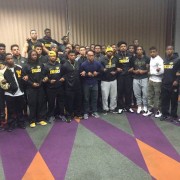Notes from the front line of art-science crossover education.
I am a professor at a university in the United States. My university recently experienced a binary fission. In a moment of administrative mitosis, the Vice President of Research was divided into a Vice President of Research and a Vice President of Innovation [1].
Is this unique to my university? I answered with less-than-innovative research (e.g., I talked to colleagues at other universities) and discovered that many universities have created administrative positions for innovation. Some have “officers” of it, others have vice presidents of it, and there are vice provosts, too.
My next question was not as clear-cut. It was unclear to me what innovation meant to the powers universities needed a vice president of it. Clearly, being innovative did not mean doing innovative research – that would not justify two VPs [2]. If my university was innovative, it wouldn’t need a VP of innovation, would it? Had those of us who work at universities become un-innovative? Had we ever been innovative? Maybe we weren’t innovative enough? Maybe we needed a VP to help us reach our innovative potential. If we did reach it, would a VP of Innovation become obsolete? Was I being less than innovative?
Seeking answers led me to the web pages of innovation centers/initiatives from varied universities [3]. I found some consistency. What stuck out was the claim that innovation centers would help university professors, postdocs, and/or students translate their research into the market. The goal was to provide a path for professors to transition their inventions/discoveries from their labs into the market.

Art by Banksy (created by an unidentified British-based street artist and activist)
Ah, yes, “The Market.” That entity decides what is of value and what is not. Why wouldn’t it also be the arbitrator of what is innovative? That also explains why many universities that appointed administrators of innovation also created administrative positions of commercialization and technology transfer [4].
I was disheartened that innovation was a buzzword for commercialization. Call me an idealist. Or call me naïve. The corporatization of universities is nothing new [5]. Increasing privatization of science, including science done at universities, is also not a new trend [6].
If innovation has become commercialization and money flow, then so be it. But those of us who don’t agree with corporate models of universities–or are incapable of ‘getting with the program’–still have research and discovery to fall back on, independent of whether it leads to increased cash flow.
Right? Wrong!
That’s because university research offices’ messaging and stated goals have changed as universities have moved toward corporatization. It has become less about discovery and more about funding. The common wording from offices of research is the need to grow research portfolios by submitting more grants for more government funding via NSF, NIH, DOE, NASA, and other funding agencies. The messaging heavily emphasizes increasing research cash flow and total funding dollars.
Portfolios and increased cash flow are not what I was taught by mentors who trained me in science. They are also not (at least in my experience) what drew my faculty colleagues to academics. Indeed, they could be the things that cause many creative people to opt out of academia or, to the detriment of the future, not to enter it at all.
If universities operate like corporations but without the equivalent monetary upside for those who work there (not including those who administrate there), why wouldn’t the next generation bypass universities and enter industry instead? If universities become ever more corporate, then won’t this push out creative individuals who don’t have interests, tendencies, or foundations in market-style competitions for personal gains? Isn’t that working against increased diversity in academics and in science?
So many more questions popped into my head [7]. One of the questions was a practical one. Suppose I accept a move to the corporatization of universities (I don’t). In that case, there is a business-driven question: Why pay high administrative salaries for research and innovation if the two have the same end goal? Couldn’t the two have remained one? What justifies two VPs?
I could have wandered down a rabbit hole of ever more questions save for recollection of a phrase and a stated goal I had run into on university websites. The phrase had variants, but the general form was this: The Office of Innovation will work closely with the Office of Research. That outcome aligned with a goal that I had read about in innovation mission statements: the Office of Innovation would facilitate the flow from ‘Research to Innovation, via marketing, to licensing with startups or established companies.’
It was now clear to me what innovation meant to universities and why they needed to appoint VPs, officers, and/or provosts of innovation. It was simple as day – from Research to Innovation …
Research, that is, getting public resources via government-funded grants to develop ideas and/or technologies
to Innovation, that is, transforming/re-framing the ideas/technologies into innovations to be commercialized for private profits.
Clever! [8, 9] The closest clever idea I know of for taking publicly funded work and turning it into private profit while denying public access (unless they pay) is academic publishing [10, 11].
A drive for “innovative” ideas (i.e., ones primed for commercialization) is in line with the growth of business schools at universities and a focus on entrepreneurial and leadership training for students [12]. It’s in synch with universities adopting business models based on the idea that companies competing with each other is the most productive way to move the economy forward.
The re-branding of research and innovation adds a spin by promoting the view that privatization is the best way to get innovations to the public for the greater societal good—a view taught to students and promoted to faculty [13]. If I was innovative, I would trademark a slogan for innovative universities: Private Profits for the Public Good.
I had answers to my initial questions about the re-branding of innovation at universities, but I was left confused. I can sum up my confusion with a bit of sarcasm: When I think about who can lead us in responsible and ethical innovation for the public good–even if decisions along the way may not align with private profits–my first thought is certainly CEOs of corporation and/or hungry entrepreneurs eager to establish their new startups.
The irony of universities of higher education touting that faculty and students could best serve the public good by linking with established companies and startups seemed so thick–so much a scheme to pre-justify a drive for profit, so lacking in honesty–that I was left looking at the sky and asking myself, “Am I the only one seeing this?”
I was pleasantly surprised to find that someone who has been called an entrepreneur had noticed a similar irony outside of the university walls [14]:
It’s one of the most absurd ironies of our neoliberal age. Having looted the public realm over the last half century in the name of the free market, we are suddenly discovering that the last refuge of public virtue is—yes, you guessed it—the private company. We are told that the only thing we “trust” these days are supposedly public-spirited corporations …. This moral Ponzi scheme is repackaging private enterprise as public virtue. It’s a fittingly tragicomic final act to the twilight years of our neoliberal age. Business schools, the seminaries of neoliberalism, have been teaching this nonsense for years.
The vice-presidential fission at my university taught me the degree to which the above continues to be taught–now with new and improved leadership training (trademark pending)–and how it is being messaged to faculty, post-docs, and all researchers who might have innovative (i.e., marketable) ideas that can solve societal problems for private profits.
A current societal problem is climate change and its associated ecological effects. Many students, who are eager to address these problems, are coming into universities with interests in environmental and ecological issues. My university, like many, now has an environmental initiative – it has already become connected to research and innovation.
Future generations do have the potential to solve ecological problems for the greater public good. And herein lies an added absurd irony. We have a future generation interested in serving the public good by addressing environmental and ecological problems that affect all citizens of the planet, irrespective of whether they can pay for an ‘elite’ university education or any intellectual products that come from universities. The students are taught that the way to do public good is through private enterprise that lets them get the commercial rewards they deserve [15].
The irony above connects to a gamble on the future. The gamble is that the market’s invisible hand, with corporate competition, is the best means for addressing climate change and associated ecological problems. Although ecology can be turned into a means for added market competition (with private investments and gains/losses), the scope of the ecological problems we face today may well go beyond the abilities of “market reason”, beyond the conditions of capitalism [16].
The gamble is no longer one of companies losing profits to the competition as market forces sort things out over time. It is a collective gamble. It is one that doesn’t break down to competitors pushing to get the most marketable ‘solution’ to the market while at the same time not sharing potentially profitable ideas or, if you like, innovations.
It may not be ironic, but it is at least creepy to have all the problems humanity may face packaged as opportunities for entrepreneurship [17, 18].
There is an old-school view that innovation is more about creativity than marketability. Holding to that view, I will end with a quote from a collection of essays by David Bohm on creativity. The quote-made long before climate change and environmental/ecological issues became prominent–shows the absurdity and dangers of privatizing public good, particularly when the public good is environmental [19]:
If, without their knowing it, the people who study ecology and try to apply their knowledge of it are themselves committed to their own personal interests or to the interests of their own economic, political, social, or national groups, how can they allow the whole to be the first in their thoughts? Inevitably, there will be subliminal pressures and tendencies to think in a fragmentary way that would seem to be appropriate to what is believed to be the overwhelming necessity of putting personal or group interests first. Thus, it will not be possible to think of and talk about all aspects that are relevant to the totality of the ecological cycles of the planet.
What, then, is the value of calls to political, social, or economic action when we cannot give proper attention to what we are doing because our minds are in a state of chaos by looking at everything, including ourselves, in a fragmentary way?
AL 230901
Acknowledgments: Several friends and colleagues provided valuable feedback on this essay: John Traphagan, Andrea Saltelli, and Bjoern Brembs, to name a few. I very much appreciated it. Peter Murray-Rust provided an email comment that was so spot on to me that I will include a portion of it here: “I’ve worked in the (well-funded) industry – pharma – for 15 years, and the last thing they want is academic innovation into the market. They want to work with and hire really good people from academia, they want academia to explore new ideas in public. I’ve seen a company waste 250M (10+ years ago) by not reading the public literature. I’d say that pharma needs more pre-competitive research …. Having university fight university destroys the system.”
__________________
Notes and References
[1] In this case, innovation does not relate to innovations in education (that’s a whole separate thing). It is about innovations connected to research carried out at a university. In the past, many universities considered a VP of Research to be, in effect, a VP of Research and Innovation. Some universities called that out explicitly in the VP title, while for others, it was more implicit.
[2] Before the binary fission, I had thought that research at a research institution was, by definition, innovative, but clearly, I was wrong, given that one administrative staff was now required to facilitate/oversee research. In contrast, another administrative staff was required to facilitate/oversee innovation.
[3] A new administrator (be it a VP or Vice Provost) can’t achieve significant goals without an Office of Something (or so the argument goes). Sometimes it’s not an Office Of but a newly formed Institute or a campus-wide Initiative.
[4] A new vice president or vice provost needs added staff support if a new institute or office of something or initiative is to succeed (or so the argument goes).
[5] Maisuria, A., and Helmes, S. (2019) Life for the Academic in the Neoliberal University, Abingdon, Oxon: Taylor & Francis; Mittelman, J.H. (2018) Implausible Dream: The World-Class University and Repurposing Higher Education, Princeton: Princeton University Press; Slaughter, S., and Leslie, L.L. (1997) Academic Capitalism: Politics, Policies, and the Entrepreneurial University, Baltimore: Johns Hopkins University Press; Smyth, J. (2017) The Toxic University: Zombie Leadership, Academic Rock Stars, and Neoliberal Ideology, London: Palgrave Macmillan.
[6] Krimsky, S. (2004) Science in the Private Interest, Rowman & Littlefield Publishers; Mirowski, P. (2011) Science-Mart, Cambridge: Harvard University Press; Cohen, D. and Mikaelian, A. (2021) The Privatization of Everything, London: Chelsea Green Publishing.
[7] What if I can do decent research for cheap, even for no cost to government agencies that and my university colleagues often write proposals to – Would I be helping to increase my university research portfolio? I sat on review panels for the National Science Foundation and NASA, and they are already stressed to find reviewers for all the proposals they get. So, what happens when the number of submitted proposals doubles? How will peer review manage to remain fair if an already stressed workload is increased? Do my colleagues have time to write more proposals, given they already write a lot and have that pesky education thing getting in the way (still listed on university mission statements)? Maybe the answers will come from what I foresee as the Vice President of Artificial Intelligence, the VP of AI, who will motivate faculty to use AI (e.g., ChatGPT) to write research proposals (some scientists already use it to write research papers). Maybe proposals can also be reviewed by AI. That would make more market sense than recruiting yet more peer reviewers and/or panel members who should be writing more proposals versus reviewing them (if you see a worrisome feedback potential here that can take humans out of the loop, then you are not ‘with the program’). The VP of AI would, I am sure, discover many more things at a university that AI could replace… except, of course, administrative positions.
[8] Not only is it a clever idea, but it can also be used to justify two separate vice presidents. One has to negotiate research grants, many of which come from publicly funded programs, while the other deals with the private sector. Plus, the vice president of research can still motivate faculty members who have research ideas that can generate grant funding but that are not innovative in the sense that they can flow to the purvey of the vice president of innovation.
[9] I could have referred to the idea as innovative, but clever seemed more fitting. While writing, an image from one of the Jurassic Park movies popped into my head. In the scene, a dinosaur hunter is about to fire on a velociraptor when he realizes he has walked into a trap. He can’t help but admire the cunningness of the velociraptors when he realizes what has happened and what is about to happen. He looks into the eyes of the velociraptor that made him aware of the trap and says: “Clever.”
[10] Monbiot, G. (2011) Academic publishers make Murdoch look like a socialist, The Guardian, https://www.theguardian.com/commentisfree/2011/aug/29/academic-publishers-murdoch-socialist; Haack, S. (2019) The Academic-Publication Racket: Whatever Happened to Authors’ Rights? Borderless Philosophy, 2, 1-21; Neff, M.W. (2020) How Academic Science Gave Its Soul to the Publishing Industry, Issue in Science and Technology, 36 (2), 35-43; Yup, K. (2023) How Scientific Publishers’ Extreme Fees Put Profit Over Progress, https://www.thenation.com/article/society/neuroimage-elsevier-editorial-board-journal-profit/
[11] The publishing connection makes it clear that I have no chance of being innovative as I am opposed to the privatization of academic knowledge and keeping scientific research behind paywalls: Brembs, B., Lenardic, A., Murray-Rust, P., Chan, L. and Erwin Irawan, D. (2023) Mastodon over Mammon – Towards publicly owned scholarly knowledge, https://doi.org/10.5281/zenodo.7974099. I am so not with the program that I even interact with people who are researching ways to make scientific findings more easily accessible to the public for free – talk about un-innovative. To be clear, I have no issues with and nothing against private companies and/or startups. I have interacted with technology companies. One was a startup for a science outreach project (https://roadsidescience.wordpress.com/2013/12/07/skate-park-physics/), I have given presentations at startup workshops (https://www.youtube.com/watch?v=yZqE-HoNR1Y), and I maintain contact with a former student who is developing startup training courses. I have issues with morphing public knowledge and public goods into private goods to be sold back to the public, especially when the public has already supported the work. I realize that, starting with the Bayh-Dole Act of 1980, all of this is legal, but legal and ethical are not equivalent.
[12] Parker, M. (2018) Why We Should Bulldoze the Business School, The Guardian, https://www.theguardian.com/news/2018/apr/27/bulldoze-the-business-school ; Smyth, J. (2020) The Making of Bullshit Leadership and Toxic Management in the Neoliberal University, Social Epistemology Review and Reply Collective, 9 (5), 9-18 https://wp.me/p1Bfg0-50m
[13] To fire up the faculty and help galvanize support for new initiatives, many universities will have lecture series around the theme of the initiative (e.g., innovation and entrepreneurship). My own university had such a series titled “Betterment of the World.” The head of a new entrepreneurship initiative, the main speaker, was advertised to discuss “the challenges in commercializing university research discoveries and how to overcome these variables to help more basic research move from the lab to market for the betterment of all.”
[14] Keen, A. (2022) Neoliberal Pieties and Business School Empathy Aren’t Getting Us Out of This Mess, Literature Hub, https://lithub.com/neoliberal-pieties-and-business-school-empathy-arent-getting-us-out-of-this-mess/
[15] Universities have become good at teaching students, viewed as customers at modern universities, that their education is about getting the training they deserve so they can get what they deserve in the world of the free market (e.g., Madary, E. (2023). Where Rich Students Are Told: ‘You Deserve This’, The Chronicle of Higher Education, https://www.chronicle.com/article/where-rich-students-are-told-you-deserve-this). Deserve is a short step from entitled to. A philosopher (talking about an un-innovative profession) has defined an asshole as someone who “allows himself to enjoy special advantages in social relations out of an entrenched sense of entitlement that immunizes him against the complaints of other people.” James, A. (2012), Assholes: A Theory, New York: Doubleday. In the same book, the philosopher observes (I am paraphrasing) that if one wants more assholes in the world, then replace more humanities departments at universities with business schools.
[16] Žižek, S., (2008), Censorship Today: Violence, or Ecology as the New Opium, for the Masses, https://www.lacan.com/zizecology1.htm; Monbiot, G. (2021) Capitalism is Killing the Planet, The Guardian, https://www.theguardian.com/environment/2021/oct/30/capitalism-is-killing-the-planet-its-time-to-stop-buying-into-our-own-destruction
[17] A definition of Entrepreneur from the Urban Dictionary: What drug dealers put in their Instagram bio https://www.urbandictionary.com/define.php?term=Entrepreneur. I am not implying that there is a blanket view of entrepreneurship. Just the opposite in fact. As with many things, there is good and there is bad, and there is the potential to hide the reality of any particular situation behind a generic label. What is worrisome is how Entrepreneurship, focused on marketability and profit, is being advertised as what is of the greatest value to students entering universities of higher education and academia in general. Ethics takes a back seat (beyond absurd online ‘training’ videos on ethics). An analogy comes to my mind as a fan of international football. Many students of the game find it worrisome that players are being coached to “gain an advantage,” which, in everyday language, translates to anything between stretching the rules and cheating in a way that doesn’t get you caught.
[18] From a personal viewing point, there is an added irony. Many Earth and Environmental Scientists express how they want to do public good in the face of climate change and environmental challenges. Yet, resistance to privatizing knowledge related to environmental issues is rare from that same group of scientists. It’s as if most scientists wanting to do public good are happy to fall in line with universities seeking to pair with private corporations and startups with the thought that there will be no conflict of interest. It is ironic to me that so many smart and generally skeptical, in a good way, people are willing to put faith in administrators, company CEOs, and hungry entrepreneurs seeking to launch startups with a “what could go wrong?” attitude.
[19] Bohm, D. (1996), On Creativity, Routledge, New York: NY



